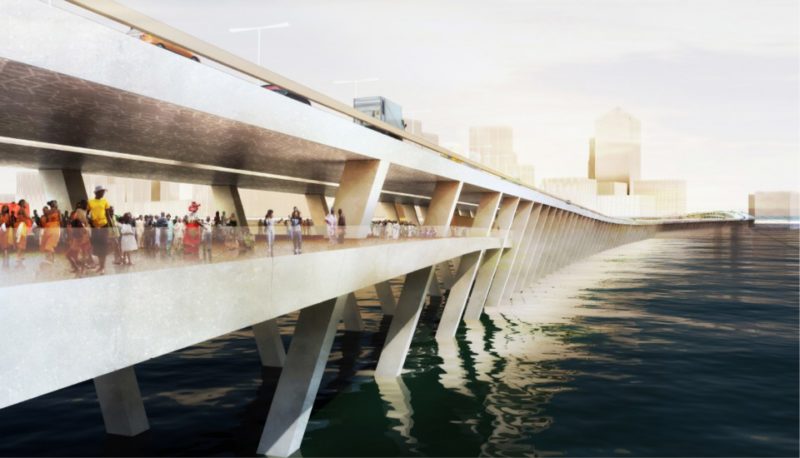Lagos State Government on Wednesday signed a memorandum of understanding (MoU) to kick-start the construction of the 38km 4th Mainland Bridge, expected to bring a 14-year-old dream to reality.

The bridge, which is geared towards economic growth in the state, is expected to gulp N844 billion in a public-private partnership (PPP) initiative and would be delivered in three years.
Speaking at the signing of the MoU held at the Banquet Hall, Lagos House, Ikeja, Lagos State governor, Akinwunmi Ambode, said that the need for the bridge had become imperative following the phenomenal growth of the state with a population of over 21 million people, which has in turn increased commercial activities and traffic gridlock.
“This has made it imperative for us to have a 4th Mainland Bridge that will serve as an alternative route to the eastern axis and decongest traffic in the state.
“More importantly this bridge will provide the required transportation compliment to the rapidly growing industrial activities on the Eti-Osa-Lekki-Epe corridor of the state,” Ambode said.
He said the proposed alignment of the bridge will pass through Lekki, Langbasa and Baiyeiku towns along the shoreline of the Lagos Lagoon estuaries, further running through Igbogbo River Basin and crossing the Lagos Lagoon estuaries to Itamaga area in Ikorodu.
The governor said the alignment would also cross through the Itoikin Road and the Ikorodu-Sagamu Road to connect Isawo inward Lagos-Ibadan Expressway at the Ojodu Berger axis.
He said the bridge would be made up of eight interchanges to facilitate effective interconnectivity between different parts of the state.
“This structure will be a four-lane dual carriageway with each comprising three lanes and two metres hard shoulder on each side. The bridge will be constructed to have a generous median to allow for both future carriageway expansion and light rail facility. There is no gainsaying the fact that huge benefits will be derived from this project but most importantly, make life more comfortable for Lagosians,” he said.
Expressing confidence that the project would be delivered on a win-win framework for all investors, the governor said that, for the first time in the history of the state, the government was embarking on the construction of a long-span bridge and expressway without federal funding as the project is to be solely funded by the private sector.
“I am delighted that this project which has been on the drawing board for quite some time is now set to become a reality. This again, is the continuity with improvement which we promised Lagosians.
“We have started the process with the signing of this MOU which is an expression of the commitment of major stakeholders including the government and the consortium of consultants and investors to the delivery of the project within the scheduled time frame,” the governor said.
The bridge, among others, will accommodate cyclists and pedestrians and feature two service areas as well as additional pedestrian crossing.
It will also accommodate three toll plazas which are still being tested from financial point of view and serve as a major boost to the actualisation of the Lekki Master Plan.
The project is to be financed by Africa Finance Corporation, Access Bank and other private investors who have already signified intention to be part of the construction, while Visible Assets Limited will be the coordinating firm.
In his remarks, Executive Chairman of Visible Assets Limited, Mr. Idowu Iluyomade, said the project would go a long way to reduce traffic gridlock in the state and provide job opportunities for Lagosians.
He said aside improving the quality of life of the people, the bridge would also be a big asset to be handed to the Lagos State Government at the end of the concession, assuring that it would be delivered on schedule.
Earlier, Commissioner for Works and Infrastructure, Engr. Ganiyu Johnson, said that the bridge, when completed, would utilise state-of-the-art tolling system that will ensure free flow of traffic.
Prior to the proposed overpass, three bridges had previously been built in Lagos within 90 years to connect the Island to the Mainland.
The first of the three bridges connecting the Lagos Island to the Lagos Mainland is the Carter Bridge. Built in 1901, it was constructed by the British colonial government, prior to the Nigerian independence in 1960. After independence, the bridge was dismantled, redesigned and rebuilt during the late 1970s. The Alaka-Ijora Flyover, on the Iddo end of the span, was completed in 1973.
This was followed by the Eko Bridge, which is the shortest of three bridges connecting the Island to the Mainland. It starts from Ijora on the Mainland and ends at the Apongbon area of the Island. The bridge and its landward extension of 1,350 metres were constructed in phases between 1965 and 1975. It serves as the preferred access point for vehicular traffic approaching Lagos Island from the Apapa and Surulere areas of Lagos.
In the bid to further ease the increasing stress resulting from commuters’ accessing the Island from the Mainland, the Federal Government embarked on the ambitious Third Mainland Bridge, which turned out to be not just the longest of the three bridges connecting the Island to the Mainland, but in fact the longest bridge in Africa.
The 11.8km long structure takes off from Oworonshoki which is linked to the Apapa-Oshodi Expressway and Lagos-Ibadan Expressway, and ends at the Adeniji Adele Interchange on Lagos Island. There is also a link midway through the bridge that leads to the Herbert Macaulay Way, Yaba. Built by Julius Berger Nigeria Plc, the bridge was opened by President Ibrahim Babangida in 1990.

The artist impression of the bridge showed a double deck structure, but the description never mentioned such. So I believe that impression was not representing the 4th. Mainland bridge.